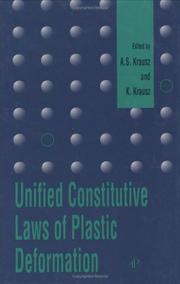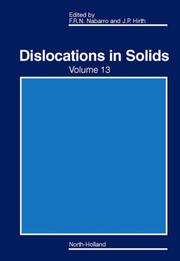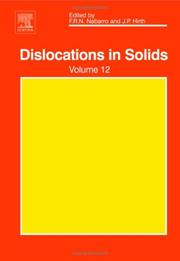| Listing 1 - 10 of 36 | << page >> |
Sort by
|
Book
ISBN: 148758587X 9781487585877 9781487586850 Year: 1971 Publisher: Toronto
Abstract | Keywords | Export | Availability | Bookmark
 Loading...
Loading...Choose an application
- Reference Manager
- EndNote
- RefWorks (Direct export to RefWorks)
Concise, logical, and mathematically rigorous, this introduction to the theory of dislocations is addressed primarily to students and researchers in the general areas of mechanics and applied mathematics. Its scope encompasses those aspects of dislocation theory which are closely related to the theories of elasticity and macroscopic plasticity, to modern continuum mechanics, and to the theory of cracks and fracture. The volume incorporates several new and original pieces of work, including a development of the theory of dislocation motion and plastic strain for non-linear materials, a new discussion of the line tension model, revised calculations of the Peierls resistance, and a new development of the van der Merwe theory of crystal interfaces.
Dislocations in crystals. --- Crystals, Dislocations in --- Dislocation theory --- Dislocations (Crystals) --- Crystallography --- Crystals --- Deformations (Mechanics) --- Grain boundaries --- Plasticity --- Twinning (Crystallography)
Book
ISBN: 1283006162 9786613006165 008096673X 0080966721 Year: 2011 Publisher: Amsterdam : Butterworth-Heinemann,
Abstract | Keywords | Export | Availability | Bookmark
 Loading...
Loading...Choose an application
- Reference Manager
- EndNote
- RefWorks (Direct export to RefWorks)
Dislocations are defects in the crystal structure of important engineering materials, such as metals, ceramics and semi-conductors, that strongly influence the properties of these materials. Research on dislocations was intense when the first edition of this classic work was published in the 1960's. By incorporating later developments in subsequent editions whilst retaining a concise, accessible style, Introduction to Dislocations has become established as a key resource for students, graduates and researchers. No other book on the topic is as credible and, with this new edition
Dislocations in crystals. --- Chemical & Materials Engineering --- Engineering & Applied Sciences --- Materials Science --- Crystals, Dislocations in --- Dislocation theory --- Dislocations (Crystals) --- Crystallography --- Crystals --- Deformations (Mechanics) --- Grain boundaries --- Plasticity --- Twinning (Crystallography)
Book
ISBN: 0894646176 9780894646171 Year: 1982 Publisher: Melbourne, FL : Krieger,
Abstract | Keywords | Export | Availability | Bookmark
 Loading...
Loading...Choose an application
- Reference Manager
- EndNote
- RefWorks (Direct export to RefWorks)
Dislocations in crystals --- Crystals, Dislocations in --- Dislocation theory --- Dislocations (Crystals) --- Crystallography --- Crystals --- Deformations (Mechanics) --- Grain boundaries --- Plasticity --- Twinning (Crystallography) --- Dislocations in crystals. --- Plasticité --- Dislocations --- Mecanique des materiaux

ISBN: 0124259707 9786611038335 1281038334 008054343X 9780124259706 9780080543437 9781281038333 Year: 1996 Publisher: San Diego Academic Press
Abstract | Keywords | Export | Availability | Bookmark
 Loading...
Loading...Choose an application
- Reference Manager
- EndNote
- RefWorks (Direct export to RefWorks)
High-technology industries using plastic deformation demand soundly-based economical decisions in manufacturing design and product testing, and the unified constitutive laws of plastic deformation give researchers aguideline to use in making these decisions. This book provides extensive guidance in low cost manufacturing without the loss of product quality. Each highly detailed chapter of Unified Constitutive Laws of Plastic Deformation focuses on a distinct set of defining equations. Topics covered include anisotropic and viscoplastic flow, and the overall kinetics and thermodynamics
Deformations (Mechanics) --- Plasticity --- Dislocations in crystals --- Crystals, Dislocations in --- Dislocation theory --- Dislocations (Crystals) --- Crystallography --- Crystals --- Grain boundaries --- Twinning (Crystallography) --- Mathematical models.
Book
ISBN: 1282381946 9786612381942 0444535349 0444534431 9780444535344 9780444534439 Year: 2010 Publisher: Amsterdam London North Holland
Abstract | Keywords | Export | Availability | Bookmark
 Loading...
Loading...Choose an application
- Reference Manager
- EndNote
- RefWorks (Direct export to RefWorks)
New materials addressed for the first time include the chapters on minerals by Barber et al and the chapter on dislocations in colloidal crystals by Schall and Spaepen. Moriarty et al extend the first principles calculations of kink configurations in bcc metals to high pressures, including the use of flexible boundary conditions to model dilatational effects. Rabier et al clarify the issue of glide-shuffle slip systems in diamond cubic and related III-V compounds. Metadislocations, discussed by Feuerbacher and Heggen, represent a new type of defect in multicomponent metal compounds and allo
Dislocations in crystals. --- Solid state physics. --- Physics --- Solids --- Crystals, Dislocations in --- Dislocation theory --- Dislocations (Crystals) --- Crystallography --- Crystals --- Deformations (Mechanics) --- Grain boundaries --- Plasticity --- Twinning (Crystallography)

ISBN: 1281023558 9786611023553 0080524680 0444518886 9780444518880 Year: 2007 Publisher: Amsterdam : Oxford : Elsevier North Holland ; Elsevier Science [distributor],
Abstract | Keywords | Export | Availability | Bookmark
 Loading...
Loading...Choose an application
- Reference Manager
- EndNote
- RefWorks (Direct export to RefWorks)
Dislocations are lines of irregularity in the structure of a solid analogous to the bumps in a badly laid carpet. Like these bumps they can be easily moved, and they provide the most important mechanism by which the solid can be deformed. They also have a strong influence on crystal growth and on the electronic properties of semiconductors.·Influence of dislocations on piezoelectric behavior·New mechanisms for hardening in twinned crystals·Bringing theories of martensite transformation into agreement·Atomic scale motion of dislocations in electron microscopy·Dislocati
Dislocations in crystals. --- Solid state physics. --- Physics --- Solids --- Crystals, Dislocations in --- Dislocation theory --- Dislocations (Crystals) --- Crystallography --- Crystals --- Deformations (Mechanics) --- Grain boundaries --- Plasticity --- Twinning (Crystallography)
Book
ISBN: 1281279609 1281279641 9786611279646 0080564984 008055962X 0444531661 9780444531667 Year: 2008 Publisher: Amsterdam London Elsevier Science
Abstract | Keywords | Export | Availability | Bookmark
 Loading...
Loading...Choose an application
- Reference Manager
- EndNote
- RefWorks (Direct export to RefWorks)
New models for dislocation structure and motion are presented for nanocrystals, nucleation at grain boundaries, shocked crystals, interphase interfaces, quasicrystals, complex structures with non-planar dislocation cores, and colloidal crystals. A theory for the magnetoplastic effect explains many diverse results of this type. The model has many potential applications for forming processes influenced by magnetic fields. Dislocation model for the magnetoplastic effect New mechanism for dislocation nucleation and motion in nanocrystals New models for the dislocation structur
Dislocations in crystals. --- Solid state physics. --- Physics --- Solids --- Crystals, Dislocations in --- Dislocation theory --- Dislocations (Crystals) --- Crystallography --- Crystals --- Deformations (Mechanics) --- Grain boundaries --- Plasticity --- Twinning (Crystallography)
Book
ISBN: 128230903X 9786612309038 0080932959 0444532854 9780080932958 9780444532855 Year: 2009 Publisher: Amsterdam London North Holland
Abstract | Keywords | Export | Availability | Bookmark
 Loading...
Loading...Choose an application
- Reference Manager
- EndNote
- RefWorks (Direct export to RefWorks)
Bacon and Osetsky present an atomistic model of dislocation-particle interactions in metal systems, including irradiated materials. This work is important in simulating actual behavior, removing earlier reliance on assumed mechanisms for dislocation motion. New mechanisms for dislocation generation under shock loading are presented by Meyers et al. These models provide a basis for understanding the constitutive behavior of shocked material. Saada and Dirras provide a new perspective on the Hall-Petch relation, with particular emphasis on nanocrystals. Of particular significance, deviations
Dislocations in crystals. --- Solids. --- Solid state physics --- Transparent solids --- Crystals, Dislocations in --- Dislocation theory --- Dislocations (Crystals) --- Crystallography --- Crystals --- Deformations (Mechanics) --- Grain boundaries --- Plasticity --- Twinning (Crystallography)

ISBN: 044451483X 9786610967353 1280967358 0080472540 9780080472546 9780444514837 Year: 2004 Publisher: Amsterdam : Elsevier,
Abstract | Keywords | Export | Availability | Bookmark
 Loading...
Loading...Choose an application
- Reference Manager
- EndNote
- RefWorks (Direct export to RefWorks)
This is the first volume to appear under the joint editorship of J.P. Hirth and F.R.N. Nabarro. While Volume 11 concentrated on the single topic of dislocations and work hardening, the present volume spreads over the whole range of the study of dislocations from the application by Kléman and his colleagues of homotopy theory to classifying the line and point defects of mesomorphic phases to Chaudhri's account of the experimental observations of dislocations formed around indentations. Chapter 64, by Cai, Bulatove, Chang, Li and Yip, discusses the influence of the structure of the core of
Dislocations in crystals. --- Solid state physics. --- Physics --- Solids --- Crystals, Dislocations in --- Dislocation theory --- Dislocations (Crystals) --- Crystallography --- Crystals --- Deformations (Mechanics) --- Grain boundaries --- Plasticity --- Twinning (Crystallography)
Book
ISBN: 9781620815083 1620815087 9781620814192 1620814196 Year: 2012 Publisher: New York : Nova Science Publishers,
Abstract | Keywords | Export | Availability | Bookmark
 Loading...
Loading...Choose an application
- Reference Manager
- EndNote
- RefWorks (Direct export to RefWorks)
Crystals --- Dislocations in crystals. --- Lattice defects --- Twinning (Crystallography) --- Crystals, Dislocations in --- Dislocation theory --- Dislocations (Crystals) --- Crystallography --- Deformations (Mechanics) --- Grain boundaries --- Plasticity --- Defects.
| Listing 1 - 10 of 36 | << page >> |
Sort by
|

 Search
Search Feedback
Feedback About UniCat
About UniCat  Help
Help News
News